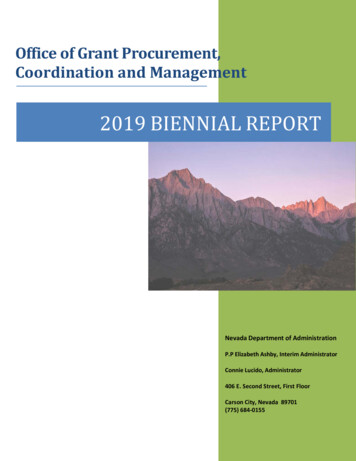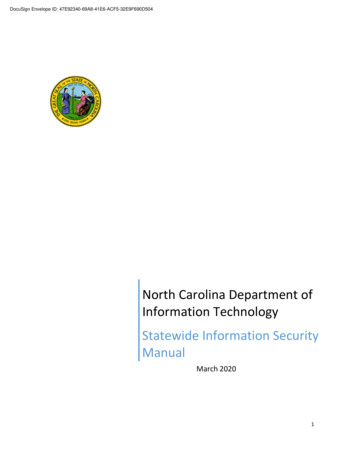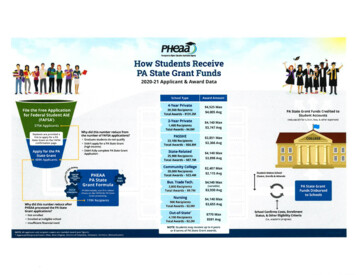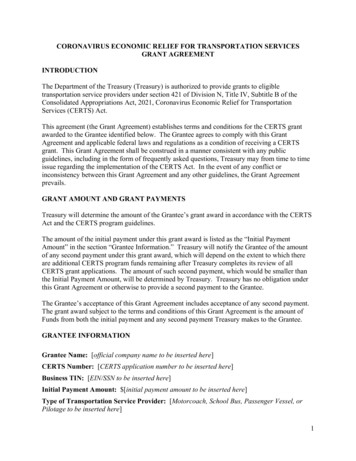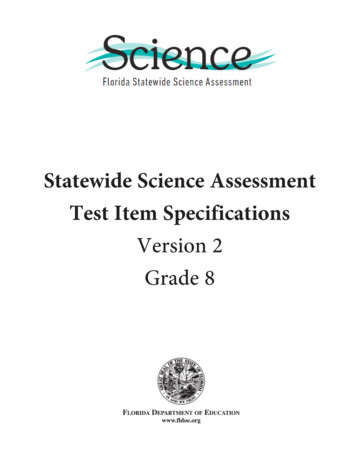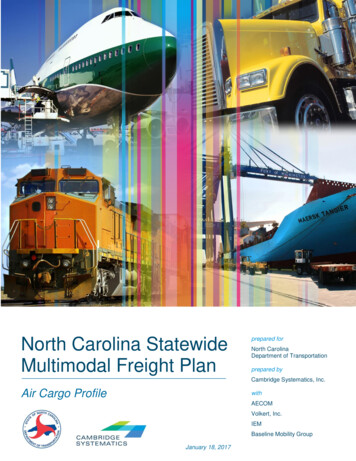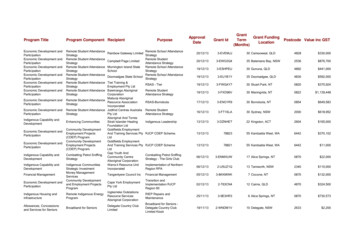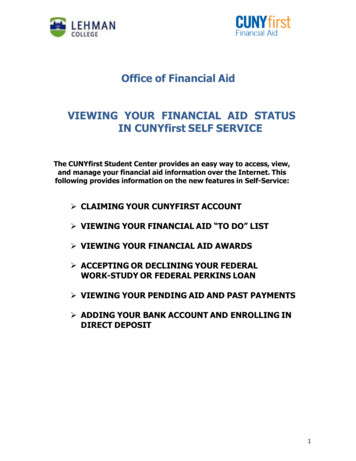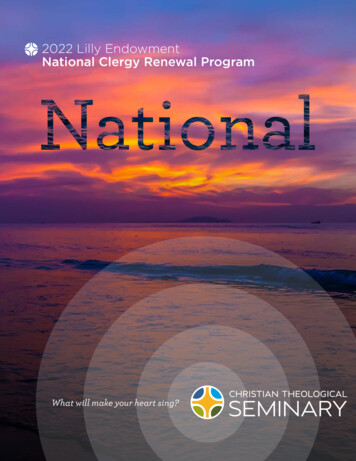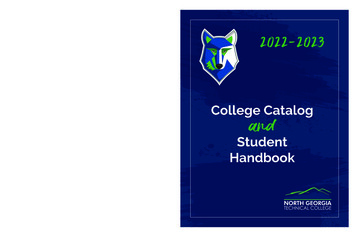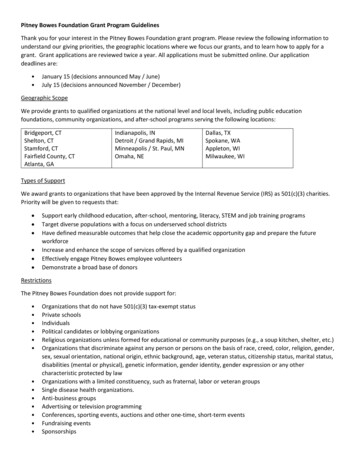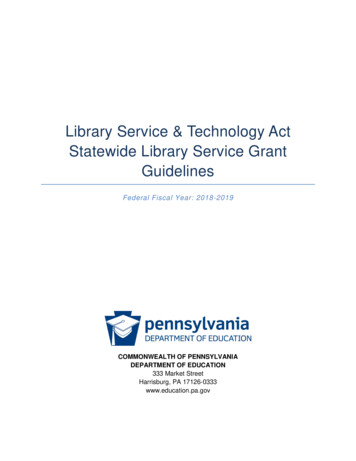
Transcription
Library Service & Technology ActStatewide Library Service GrantGuidelinesFederal Fiscal Year: 2018-2019COMMONWEALTH OF PENNSYLVANIADEPARTMENT OF EDUCATION333 Market StreetHarrisburg, PA 17126-0333www.education.pa.gov
Commonwealth of PennsylvaniaTom Wolf, GovernorDepartment of EducationPedro A. Rivera, SecretaryOffice of Commonwealth LibrariesGlenn Miller, Deputy SecretaryBureau of Library DevelopmentVacant, DirectorThe Pennsylvania Department of Education (PDE) does not discriminate in its educational programs,activities, or employment practices, based on race, color, national origin, [sex] gender, sexual orientation,disability, age, religion, ancestry, union membership, gender identity or expression, AIDS or HIV status, orany other legally protected category. Announcement of this policy is in accordance with State Lawincluding the Pennsylvania Human Relations Act and with federal law, including Title VI and Title VII ofthe Civil Rights Act of 1964, Title IX of the Education Amendments of 1972, Section 504 of theRehabilitation Act of 1973, the Age Discrimination in Employment Act of 1967, and the Americans withDisabilities Act of 1990.The following persons have been designated to handle inquiries regarding the Pennsylvania Departmentof Education’s nondiscrimination policies:For Inquiries Concerning Nondiscrimination in Employment:Pennsylvania Department of EducationEqual Employment Opportunity RepresentativeBureau of Human Resources333 Market Street, 11th Floor, Harrisburg, PA 17126-0333Voice Telephone: (717) 787-4417, Fax: (717) 783-9348For Inquiries Concerning Nondiscrimination in All Other Pennsylvania Department ofEducation Programs and Activities:Pennsylvania Department of EducationSchool Services Unit Director333 Market Street, 5th Floor, Harrisburg, PA 17126-0333Voice Telephone: (717) 783-3750, Fax: (717) 783-6802If you have any questions about this publication or for additional copies, contact:Pennsylvania Department of EducationBureau of Library Development Office of Commonwealth Libraries607 South Drive, Room 221, Harrisburg, PA 17120-0600Voice: (717) 787-3124, Fax: (717) 772-0044www.statelibrary.pa.gov/LSTAAll Media Requests/Inquiries: Contact the Office of Press & Communications at (717) 783-9802May 20182
ContentsExecutive Summary . 4LSTA Background . 4LSTA Statewide Library Service Grant Program Intent. 4LSTA Statewide Library Service Applicant Eligibility. 5General: . 6Policies and Procedures:. 7Audit . 7Experience and Capacity with Statewide Library Service Delivery: . 8Application Instructions . 8Online eGrants System . 8e-Signatures . 8Sign-Up for e-Signatures . 9Indirect Cost Instructions . 9Application Attachments .10Application Evaluation Criteria .11Award Decisions .13Application Deadline .14Funding of Projects .14Risk Assessment .14LSTA Statewide Library Service Award Agreement/Formal Contract .14Contract Signatures .15e-Signatures .15Manual Signature .15Reimbursement:.16LSTA Statewide Library Service Award Recipient Requirements .16Record Retention .16Cash Management .16Financial Reports .16Federal Single Audit Requirement.16Inventory .17Indirect Cost Payments .17SAM.gov Registration .17Federal Funding Accountability and Transparency Act .17Assurances – Non-Construction Programs .18Internet Safety Certification (if applicable to the grant) .18Use of Funds.18Expenditures that May Be Eligible .18Ineligible Expenditures .18Program Income .19Program Income Earned during the Grant Period .19Program Income Earned after the Grant Period .20Grant Award Acknowledgement .20Sharing Results.21Appendix A: CIPA Compliance Information .22Overview .22Affected Libraries .22Purchases That Require CIPA Compliance .22Requirements for Compliance .22May 20183
Executive SummaryFederal Library Services and Technology Act (LSTA) funds from the Institute ofMuseum and Library Services (IMLS) are available from the Pennsylvania Departmentof Education (PDE) Office of Commonwealth Libraries (OCL) to develop and implementservices for public, academic (postsecondary), school (K-12), and special libraries(including library staff and library boards) across Pennsylvania.For the grant period, October 1, 2018 – September 30, 2019, available grant funds willbe awarded to proposals that are the most competitive and most closely aligned withthe goals and outcomes outlined in Pennsylvania’s LSTA Five-Year Plan located atwww.statelibrary.pa.gov/LSTA.Eligible applicants include: Pennsylvania non-profit organizations that provide servicesto public, academic (postsecondary), and school (K-12) libraries; District Library Centersthat currently receive Public Library Subsidy funds; and library system headquarters thatcurrently receive Public Library Subsidy funds.Eligible applicants may submit an application for more than one LSTA Statewide LibraryService grant program category. Separate applications must be submitted by theapplicant for each grant program category.Applications must be submitted via the PDE eGrants system to PDE by 5:00 P.M. onFriday, June 29, 2018. Paper applications will not be accepted.LSTA BackgroundLSTA funds are available to states from the federal IMLS through a program stipulatedby LSTA to develop library services throughout the States, U.S. Territories, and theFreely Associated States. In Pennsylvania, the LSTA program is administered throughOCL.LSTA Statewide Library Service Grant Program IntentOCL is accepting applications for LSTA grants from organizations that are capable ofdeveloping and implementing statewide services for Pennsylvania’s public, academic(postsecondary), school (K-12), and special libraries such as those located at prisons.These services must support one of the following LSTA priorities:1. Lifelong Learning and Literacy: Develop and improve services andcollaborations with community organizations in all types of libraries for individualsof all ages in order to support their needs for lifelong learning and literacycompetencies in areas such as basic, civic and social, digital, financial, health,science, technology, engineering, and mathematics;May 20184
2. Digital Library Services: Increase and improve Pennsylvanians' access,knowledge, and ability to use and share digital library services, resources, andcontent;3. Training and Support: Support and enhance the skills of library staff and boardleadership, advance the delivery of library services, and improve public libraries’engagement with local community members through continuing education,professional development and the provision of relevant data, analytical tools, andresearch;4. Underserved and Populations with Special Needs: Develop and improveservices and community organization collaborations in all types of libraries forunderserved populations or for Pennsylvanians who have difficulty usinglibraries, especially those who live in poverty or who have a disability; and5. Workforce Development: Develop and improve workforce developmentservices and community organization collaborations in all types of libraries forindividuals of all ages.No specific dollar amounts have been set aside to fund grants in the categories.Available grant funds will be awarded to proposals that are the most competitive andclosely aligned with the goals and outcomes outlined in Pennsylvania’s LSTA Five-YearPlan located at www.statelibrary.pa.gov/LSTA.Successful projects may be selected for renewals at the discretion of PDE. If selected,contracts may be renewed annually for an additional four years. Each subsequent yearof the grant, after the first, is contingent upon satisfactory performance and theavailability of funds. Additionally, the award amount in subsequent years may changefrom the initial contract year. If renewed, the grant recipient will be notified in writing, onan annual basis, of the amount of the grant award and the time period in which the grantfunds must be spent.Eligible applicants may apply for more than one LSTA Statewide Library Service grantprogram category. Separate applications must be submitted by the applicant for eachgrant program category.LSTA Statewide Library Service Applicant EligibilityEligible applicants include: Pennsylvania non-profit associations that provide services topublic, academic (postsecondary), and school (K-12) libraries; District Library Centersthat currently receive Public Library Subsidy funds; and library system headquarters thatcurrently receive Public Library Subsidy funds.May 20185
In addition, the following requirements must be met:General:All LSTA Statewide Library Service applicants must:1. Be incorporated as a Pennsylvania not-for-profit corporation or be a departmentor agency of county/local government. If incorporated as a not-for-profitorganization, the applicant must be designated as a charitable organizationhaving tax-exempt status under the U.S. Internal Revenue Code (26U.S.C. § 501)2. Possess the following:a. Federal Employer Identification Number (FEIN) or EmployerIdentification Number (EIN): A 9-digit code used by businesses in orderto classify and identify them as a tax payer, for banking services and otherofficial and legal purposes. More information regarding FEINs can befound on the Internal Revenue Service website ein-online.b. Pennsylvania Vendor Number: This number is required for entities thatreceive payments or grants from the Commonwealth of Pennsylvania. Ifyou are registering for the first time and do not think you’ll ever providegoods or services that the commonwealth would purchase, you shouldregister for a Pennsylvania Non-Procurement Vendor Number at:www.vendorregistration.state.pa.us. For questions about PennsylvaniaVendor Numbers, review the Pennsylvania Office of the Budget’s NonProcurement Vendor Help ProcurementHelp.aspx or contact the Vendor Data Management Unit at rapsc supplier requests@pa.gov.c. Administrative Unit Number (AUN): An AUN is a nine-digit numberassigned by PDE to identify entities such as libraries, school districts,intermediate units, higher education institutions, professional educationassociations, etc. To verify an existing Administrative Unit Number, visit:www.edna.ed.state.pa.us. Or, to register for an AUN, email ra-ednaadmin@pa.gov.May 20186
d. Dun & Bradstreet D-U-N-S Number: A D-U-N-S number is a uniquenine-digit identifier for businesses. It is used to establish a business creditfile, which is often referenced by lenders, potential business partners andthe federal government to help predict the reliability and/or financialstability of the business. To register for or to verify an already existing DU-N-S Number, visit: www.dnb.com. (To ensure that you don’t registerunnecessarily, be sure to verify whether you have a number first.)Policies and Procedures:To comply with the federal Uniform Administrative Requirements for grants (2 CFR§200.300 - §200.345), all LSTA Statewide Library Service applicants must have awritten:1. Cash management procedure that establishes LSTA fund controls andaccountability, including written procedures for determining the allowability ofcosts under the terms and conditions of the LSTA award (2 CFR §200.302(b)(6),§200.302(b)(7), §200.305);2. Bid and procurement procedure that establishes standards and controls for thepurchase of all goods and services, including written procedures for theevaluation of the proposals received and for selecting awardees (2 CFR§200.319(c), §200.320(d)(3));3. Conflict of interest policy that governs the actions of its employees and boardmembers who engage in the selection, award, and administration of contracts,including disciplinary actions if the policy is violated (2 CFR §200.318(c));4. Travel policy (2 CFR §200.474(b));5. Compensation and fringe benefit policy, if any federal funds are used forcompensation and fringe benefits (2 CFR §200.430(a), §200.431(a), §200.464[Relocation Costs of Employees]); and6. Indirect cost rate development procedures if an indirect cost rate other than10 percent has been negotiated directly with the federal government. (2 CFR§200.414, §200.331(a)(4), Appendices).For more information on policies and procedures that comply with the federal UniformAdministrative Requirements for grants (including sample), visitwww.statelibrary.pa.gov/LSTA.AuditApplicants must have conducted an annual audit in accordance with generally acceptedauditing standards for its most recent annual accounting period. If findings werereported on the applicant’s most recent annual audit, the applicant must show evidenceMay 20187
of the implementation of a corrective action plan or show satisfactory evidence as towhy a corrective action plan is not feasible or needed at this time.Experience and Capacity with Statewide Library Service Delivery:Applicants must demonstrate that they have the requisite experience and capacityneeded to provide statewide services to public, academic (postsecondary), school (K12), and special libraries and library staff across Pennsylvania.Application InstructionsOnline eGrants SystemThe PDE uses eGrants, an online system for the submission and management of grantapplications and contracts: www.egrants.pa.gov. For technical assistance, contactthe eGrants help desk at 1.888.498.8129 or ra-egrantshelp@pa.gov.The eGrants system is available to all participating agencies eligible to apply for andreceive educational grants including libraries, school districts, charter schools,intermediate units, and other institutions.Each applicant organization must have an Agency User Administrator. TheAdministrator is responsible for creating and managing eGrants user accounts forothers who need to use the organization’s grant applications or contracts.If no one in your organization has an Agency User Administrator account, you’ll need todesignate someone to act as the Agency User Administrator (usually the director). Thatperson should email ra-lsta@pa.gov with the subject line: “Need eGrants Agency UserAdministrator Login” and give their contact information.Once an Agency User Administrator account is created, the Administrator will receivean email with the subject “eGrants Alert Message” from ra-egrantshelp@pa.gov. It willprovide the Administrator with a temporary password. The Administrator then must goto the eGrants site to set-up their own password, complete their profile, and set up anyother user accounts.An email confirmation will be sent from ra-egrantshelp@pa.gov. As a precaution,eGrants users should add ra-egrantshelp@pa.gov to their email’s safe senders list,since eGrants sends notifications via a technique similar to SPAM.Once logged in, the “Getting Started Guide” that covers the basic functions of eGrants islocated on the right side of the eGrants home page.e-SignaturesApplicants must decide if they want to use e-Signatures for the application beforeapplying and submitting a grant application. Applicants electing to use e-signatures areMay 20188
not required to manually sign and mail the grant agreement. Instead, authorizedindividuals will be able to conveniently affix e-signatures and submit e-signed grantagreements via the Internet. This will make the state’s application and contractsprocess much faster and reduces copying and postage costs for your organization. Theuse of e-signatures is voluntary and if your organization decides not to participate, youwill still be able to print and manually sign the grant agreement.Sign-Up for e-SignaturesIf you decide to use e-Signatures:1. Ask your board of directors to adopt the required eGrants Signature Resolutionwhich identifies and authorizes the library director to sign electronic documentson eGrants. Please note that the Resolution must be submitted to PDE beforebeing able to sign and submit a contract on the eGrants system. A fillableeGrants Signature Resolution is available at http://www.statelibrary.pa.gov/LSTA.It must be: Completed and adopted as it is written; Signed by the appropriate board officers in blue ink; Attested to by the governing body’s secretary; and Signed by the authorized signer in blue ink.2. Update or create a user profile for the authorized signer in eGrants. Instructionsare attached. (The authorized signer’s user profile must already exist for PDE tocomplete the e-Signature process.)3. After the user profile for the authorized signer has been created, mail the originalresolution document (signed in blue ink) to:Pennsylvania Department of EducationBureau of Management Services333 Market Street, 15th FloorHarrisburg, PA 171264. PDE will not accept photocopies or scanned/emailed Resolutions.If you have any questions about e-Signatures, contact Bureau of Management Servicesat RA-FINTRANS@pa.gov or 717 346-9725.Indirect Cost InstructionsTo support the indirect costs associated with developing and implementing statewidelibrary services, LSTA Statewide Library Service award recipients are eligible for up to10 percent of the grant award as payment for indirect costs. (Or, if the LSTA StatewideLibrary Service award recipient has negotiated another indirect cost rate with the federalgovernment, it may charge up to the percentage specified in that agreement.)May 20189
Indirect costs are defined as those that are incurred which cannot be readily isolated oridentified with only one project or activity. These types of costs are often referred to as"overhead costs." Typical examples are charges for utilities, general insurance, use ofoffice space and equipment that you own, local telephone service, and the salaries ofthe management and administrative personnel of the organization.LSTA Statewide Library Service applicants may opt for one of the following threeoptions:1. Do not include any indirect costs (0 percent of the grant award); or2. Select a percentage rate of the grant award that does not exceed 10 percent ofthe total indirect costs; or3. Select an indirect cost rate that does not exceed the percentage that has beennegotiated with the federal government by your organization. If this option isselected, you must include a copy of the current negotiated agreement as anattachment.If you selected option number two (2) or three (3) from the indirect costs menu in theapplication, enter the indirect cost percentage value in the field located next to theindirect cost drop-down menu. For example, enter 0.07 in the percentage field if yourindirect cost rate is 7 percent of the total award.Application AttachmentsClearly named, scanned copies of all the documents supporting the project should beuploaded individually into the Attachments section of the online application.Attachments over 3MB (megabytes) are not accepted in eGrants. If you are scanningyour attachments, please set the scanner resolution to low. Attachments can only besubmitted in Word, Excel, or PDF formats.Requested documents include:1. Cash management procedure;2. Bid and procurement procedure;3. Conflict of interest policy;4. Travel policy;5. Compensation and fringe benefit policy (if federal funds are used forcompensation and fringe benefits);6. Indirect cost rate development procedure (if an indirect cost rate other than 10percent has been negotiated directly with the federal government);7. Annual audit for the most recent annual accounting period including evidence ofthe implementation of a corrective action plan, or why a plan is not feasible orneeded at this time;May 201810
8. Supporting documents that demonstrate the applicant’s experience and capacitywith developing and implementing statewide library services;9. Internet Safety Certification for Applicant Public Libraries, Public Elementary andSecondary School Libraries, and Consortia with Public and/or Public SchoolLibraries (CIPA) available at www.statelibrary.pa.gov/LSTA; and10. Completed Assurances – Non-Construction Form available atwww.statelibrary.pa.gov/LSTA.Application Evaluation CriteriaApplications that are incomplete or that do not meet the minimum requirements asoutlined in this document will be disqualified.Reviewers will use the point values below in determining a score for each application.CriteriaNeed for ProposedProject: The need forthe proposed project isclearly linked to thetarget population and issupported by qualitativeand quantitative data.Strategic Plan:The organization’sstrategic plan supportsthe implementation ofthe proposed project.Project Results:The proposed project’sresults are reasonableand achievable withinthe project’s timeframe.Project Purpose:The proposed project’spurpose statement isclear and identifies abenefit that is desirablefor the grant categoryarea.Project Activities:The proposed project’sactivities and methodssupport project goalsand projected results.May 2018Best (Points)Good (Points)Fair (Points)Poor20The need is stronglyand clearly articulated.Both qualitative andquantitative data isprovided that supportsthe target audience’sneed for the proposedproject.20The applicant’s strategicplan supports theproposed project’simplementation,specificallyrecommending itsimplementation.10The need is clearlyarticulated. Eitherqualitative orquantitative data isprovided that supportsthe target audience’sneed for the proposedproject.5The need is articulated.Little qualitative orquantitative data isprovided that supportsthe target audience’sneed for the proposedproject.0The need is not clearlyarticulated. Little to nodata is provided thatsupports the targetaudience’s need for theproposed project.---0The applicant’s strategicplan does not supportthe project’simplementation.10The proposed project’sresults are reasonablebut may not beachievable within theproject’s timeframe.---0The applicant’sproposed results are notreasonable orachievable.10The proposed project’spurpose statement isclear and identifies abenefit that is desirablefor the grant categoryarea.5The proposed project’spurpose statement isclear and identifies abenefit that may bedesirable for the grantcategory area.0The proposed project’spurpose statement isnot clear and/or doesnot identify a benefitthat may be desirablefor the grant categoryarea.---0The proposed project’sactivities and methodsdo not support its goalsand projected results.20The proposed project’sresults are reasonableand achievable withinthe project’s timeframe.20The proposed project’spurpose statement isvery clear and identifiesa benefit that is highlydesirable and innovativefor the grant categoryarea.20The proposed project’sactivities and methodsare innovative andsupport its goals andprojected results.10The applicant’s strategicplan implies support forthe project’simplementation.10The proposed project’sactivities and methodssupport its goals andprojected results.11
CriteriaBest (Points)Good (Points)20The proposed projectidentifies outputmeasures that arefeasible to collect (donot place an undueburden on participatinglibraries or library staff).The outputs support theproject’s goals andprojected results.10The proposed projectidentifies outputmeasures that arefeasible to collect butmay place some burdenon participating librariesor library staff to collect.The outputs support theproject’s goals andprojected results.ProjectCollection of theproposed project’soutcomes isfeasible/reasonable,and they support projectgoals and projectedresults.20The proposed projectidentifies outcomes thatare reasonable, andthey do not place anundue burden onparticipating libraries orlibrary staff to collect.The outcomes supportthe project’s goals andprojected results.10The proposed projectidentifies outcomes thatare reasonable but mayplace some burden onparticipating libraries orlibrary staff to collect.The outcomes supportthe project’s goals andprojected results.Project Timeline:The proposed project’simplementation plan isfeasible and achievablewithin the granttimeframe.20The proposed project’simplementation plan isfeasible and achievablewithin the granttimeframe.Project Budget:The proposed project’sbudget clearly describescosts that arereasonable and relatedto project activities andoutcomes.20The proposed project’sbudget clearly describescosts that arereasonable and relatedto project activities andoutcomes.Project Outputs 1:Collection of theproposed project’soutput measures arefeasible/reasonable andsupport project goalsand projected results.Outcomes 2:10The proposed project’simplementation plan isfeasible, but willprobably not beachievable within thegrant time frame.10The proposed project’sbudget clearly describescosts that arereasonable and relatedto project activities andoutcomes; but somerelated costs are notincluded.Fair (Points)5The proposed projectidentifies outputmeasures that arefeasible to collect butwill definitely place anundue burden onparticipating libraries orlibrary staff to collect.The outputs support theproject’s goals andprojected results.5The proposed projectidentifies outcomes thatare reasonable but willdefinitely place anundue burden onparticipating libraries orlibrary staff to collect.The outcomes supportthe project’s goals andprojected results.5The proposed project’simplementation planmay not be feasible orachievable within thegrant time frame.Poor0The proposed projectdoes not identify outputmeasures that arefeasible to collect,and/or the outputs donot clearly support theprojec
Pennsylvania Vendor Number: This number is required for entities that receive payments or grants from the Commonwealth of Pennsylvania. If you are registering for the first time and do not think you'll ever provide goods or services that the commonwealth would purchase, you should register for a Pennsylvania Non-Procurement Vendor Number at:
